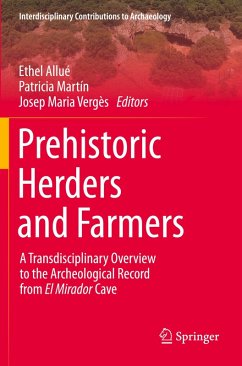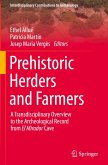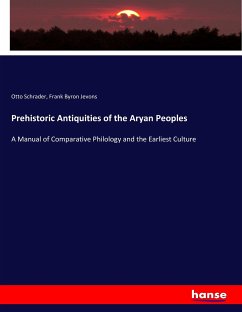Prehistoric Herders and Farmers
A Transdisciplinary Overview to the Archeological Record from El Mirador Cave
Herausgegeben:Allué, Ethel; Martín, Patricia; Vergès, Josep Maria
Prehistoric Herders and Farmers
A Transdisciplinary Overview to the Archeological Record from El Mirador Cave
Herausgegeben:Allué, Ethel; Martín, Patricia; Vergès, Josep Maria
- Broschiertes Buch
- Merkliste
- Auf die Merkliste
- Bewerten Bewerten
- Teilen
- Produkt teilen
- Produkterinnerung
- Produkterinnerung
This book presents an interdisciplinary study of the El Mirador cave located on the Atapuerca karstic system, one of the longest Pleistocene and Holocene archaeopaleontological deposits in Iberia. This book presents the results including new unpublished and published data to discuss different aspects related to the prehistoric herders and farmers that occupied this territory.
Divided into four parts, the book covers site presentation and the paleoenvironmental reconstruction covering a chronological span between 7060 ± 40-3040 ± 40 yrs. The history of the excavation and the excavation…mehr
Andere Kunden interessierten sich auch für
![Prehistoric Herders and Farmers Prehistoric Herders and Farmers]() Prehistoric Herders and Farmers81,99 €
Prehistoric Herders and Farmers81,99 €![Prehistoric Fishing in Europe and North America Prehistoric Fishing in Europe and North America]() Charles RauPrehistoric Fishing in Europe and North America26,90 €
Charles RauPrehistoric Fishing in Europe and North America26,90 €![Prehistoric Man and Beast Prehistoric Man and Beast]() H. N. HutchinsonPrehistoric Man and Beast26,90 €
H. N. HutchinsonPrehistoric Man and Beast26,90 €![Prehistoric Man and Beast Prehistoric Man and Beast]() H. N. HutchinsonPrehistoric Man and Beast26,90 €
H. N. HutchinsonPrehistoric Man and Beast26,90 €![Prehistoric man and Beast Prehistoric man and Beast]() H. N. HutchinsonPrehistoric man and Beast39,99 €
H. N. HutchinsonPrehistoric man and Beast39,99 €![Manners and monuments of prehistoric peoples Manners and monuments of prehistoric peoples]() Nancy BellManners and monuments of prehistoric peoples30,90 €
Nancy BellManners and monuments of prehistoric peoples30,90 €![Prehistoric Antiquities of the Aryan Peoples Prehistoric Antiquities of the Aryan Peoples]() Otto SchraderPrehistoric Antiquities of the Aryan Peoples34,90 €
Otto SchraderPrehistoric Antiquities of the Aryan Peoples34,90 €-
-
-
This book presents an interdisciplinary study of the El Mirador cave located on the Atapuerca karstic system, one of the longest Pleistocene and Holocene archaeopaleontological deposits in Iberia. This book presents the results including new unpublished and published data to discuss different aspects related to the prehistoric herders and farmers that occupied this territory.
Divided into four parts, the book covers site presentation and the paleoenvironmental reconstruction covering a chronological span between 7060 ± 40-3040 ± 40 yrs. The history of the excavation and the excavation methodology is detailed in this part including new unpublished recording techniques using 3D scanning and photogrammetry and a very meticulous sampling strategy. The book presents formation processes of the deposit which are key to understanding the successive occupations of the caves regarding its use as sheepfold cave as well as human remains that are part ofdifferent funerary contexts in the cave. In the last section, the book covers material culture found in the cave including lithic tools and pottery. This interdisciplinary work is of interest to scholars in anthracology, zooarchaeology, paleoanthropology, lithic technology, and experimental archaeology.
Divided into four parts, the book covers site presentation and the paleoenvironmental reconstruction covering a chronological span between 7060 ± 40-3040 ± 40 yrs. The history of the excavation and the excavation methodology is detailed in this part including new unpublished recording techniques using 3D scanning and photogrammetry and a very meticulous sampling strategy. The book presents formation processes of the deposit which are key to understanding the successive occupations of the caves regarding its use as sheepfold cave as well as human remains that are part ofdifferent funerary contexts in the cave. In the last section, the book covers material culture found in the cave including lithic tools and pottery. This interdisciplinary work is of interest to scholars in anthracology, zooarchaeology, paleoanthropology, lithic technology, and experimental archaeology.
Produktdetails
- Produktdetails
- Interdisciplinary Contributions to Archaeology
- Verlag: Agència de Gestió d'Ajuts Universitaris i de Recerca / European Regional Development Fund / Minister
- Artikelnr. des Verlages: 978-3-031-12280-4
- 1st edition 2022
- Seitenzahl: 416
- Erscheinungstermin: 21. Oktober 2023
- Englisch
- Abmessung: 235mm x 155mm x 23mm
- Gewicht: 628g
- ISBN-13: 9783031122804
- ISBN-10: 3031122801
- Artikelnr.: 69034942
- Herstellerkennzeichnung Die Herstellerinformationen sind derzeit nicht verfügbar.
- Interdisciplinary Contributions to Archaeology
- Verlag: Agència de Gestió d'Ajuts Universitaris i de Recerca / European Regional Development Fund / Minister
- Artikelnr. des Verlages: 978-3-031-12280-4
- 1st edition 2022
- Seitenzahl: 416
- Erscheinungstermin: 21. Oktober 2023
- Englisch
- Abmessung: 235mm x 155mm x 23mm
- Gewicht: 628g
- ISBN-13: 9783031122804
- ISBN-10: 3031122801
- Artikelnr.: 69034942
- Herstellerkennzeichnung Die Herstellerinformationen sind derzeit nicht verfügbar.
Dr. Ethel Allué is a researcher at IPHES-CERCA since 2005. She is an expert on charcoal with a main focus on the study of past environment and wood uses, especially fuel. She has worked in different areas of the world, mostly located in the northern hemisphere, the Mediterranean and temperate areas in contexts from the early Pleistocene to historical times. She is associated lecturer on Prehistory at the History degree at the University Rovira i Virgili. Dr. Patricia Martín is a postdoctoral researcher "María de Maeztu" at IPHES-CERCA. Her research focuses on the study of early husbandry practices in the Mediterranean region and of the symbolism of domestic animals in funerary contexts. She uses zooarchaeology, taphonomy and isotope datasets to investigate animal exploitation and human interaction. He participates in different research projects, among which is that of the excavations in the Sierra de Atapuerca. Dr. Josep Maria Vergès is a researcher at IPHES-CERCA since 2005. He is an expert in lithic technology, usewear analyses and experimental archaeology. He has experience working on archaeological contexts from different periods from early Pleistocene to historical times. His long-lasting experience in archaeological field work has allowed him to direct a number of excavations among which El Mirador cave. He is associated lecturer at the Experimental Archaeology and Microscopy courses from the Quaternary and Archaeology Master Degree at the University Rovira i Virgili.
Foreword.- Acknowledgements.- Chapter 1. Introduction (Ethel Allué, Patricia Martín, Josep M. Vergès).- Part I: The site and its palaeoenvironment.- Chapter 2. El Mirador cave: biogeographical setting and site description (Josep M. Vergès, Marta Fontanals, Manuel Vaquero, Josep Zaragoza, Diego E. Angelucci, Sergio Moral, Artur Cebrià, Juan Ignacio Morales, Anna Rodríguez, Patricia Martín, Ethel Allué).- Chapter 3. Vegetation and climate at El Mirador cave: exploring the beginning of cultural landscapes (Isabel Expósito, Ethel Allué, Francesc Burjachs).- Chapter 4. Small vertebrate accumulations from El Mirador cave: a climate and ecological analysis (Sandra Bañuls-Cardona, Josep F. Bisbal-Chinesta).- Part II: Formation processes.- Chapter 5. The fumier sequences of El Mirador: an approach to fire as a sociocultural practice and taphonomic agent (Aitor Burguet-Coca, Héctor del Valle, Isabel Expósito, Ángela Herrejón Lagunilla, Dan Cabanes, Erika Buitkute, Isabel Cáceres, Ángel Carrancho, Juan J. Villalaín).- Chapter 6. On the suitability of prehistoric anthropogenic burnt sediments (fumiers) for archaeomagnetic studies at El Mirador cave (Ángela Herrejón-Lagunilla, Ángel Carrancho, Juan J. Villalaín).- Part III: Humans and funerary practices.- Chapter 7. Funerary practices at El Mirador cave (Josep M. Vergès).- Chapter 8. Life and death in El Mirador cave. Anthropological and palaeopathological analysis of a collective burial (Javier Iglesias-Bexiga, Marta Yustos, Francisco Etxeberria Gabilondo).- Chapter 9. Dental and oral pathologies at El Mirador cave (Sierra de Atapuerca, Spain) (Marina Lozano, Beatriz Gamarra, Raquel Hernando, Dolors Ceperuelo).- Chapter 10. Characterization of the processing of human bodies in the case of cannibalism at El Mirador cave (Francesc Marginedas, Palmira Saladié, Antonio Rodríguez-Hidalgo, Miguel Ángel Moreno-Ibáñez).- Chapter 11. Genomic analysis of the individuals from El Mirador cave (Iñigo Olalde, Carles Lalueza-Fox, David Reich).- Part IV: Subsistence activities and landscape management.- Chapter 12. Husbandry and wild animal exploitation. Characteristics and evolution from a multidisciplinary perspective (Patricia Martín, Isabel Expósito, Aitor Burguet-Coca, Jaime Lira, Àngel Blanco-Lapaz, Carlos Tornero).- Chapter 13. Lipid biomarkers as a tool for the identification of herder activities in El Mirador cave (Asier Vallejo, Jaime Gea, Laura Massó, Blanca Navarro, Ane Gorostizu-Orkaiztegi, Josep M. Vergès, Alicia Sánchez-Ortega, María Carmen Sampedro, Erika Ribechini, Ramón J. Barrio).- Chapter 14. Forest management and agriculture practices at El Mirador cave (Nit Cano-Cano, Aitor Burguet-Coca, Itxaso Euba, Isabel Expósito, Ethel Allué).- Chapter 15. Human diet at El Mirador cave (Raquel Hernando, Nit Cano-Cano, Patricia Martín, M. Cemre Üstünkaya, Ethel Allué, Marina Lozano).- PART V: Material culture.- Chapter 16. Early neolithic pottery at El Mirador cave (F. Xavier Oms, Roser Marsal, Maria Yubero, Xavier Rubio-Campillo).- Chapter 17. The lithic technology from El Mirador cave: a diachronic study of the stone tools (Miquel Guardiola, Eduy Urbina).- PART VI: Discussion.- Chapter 18. El Mirador cave herders and farmers (Patricia Martín, Ethel Allué, Josep M. Vergès).- Index.
Foreword.- Acknowledgements.- Chapter 1. Introduction (Ethel Allué, Patricia Martín, Josep M. Vergès).- Part I: The site and its palaeoenvironment.- Chapter 2. El Mirador cave: biogeographical setting and site description (Josep M. Vergès, Marta Fontanals, Manuel Vaquero, Josep Zaragoza, Diego E. Angelucci, Sergio Moral, Artur Cebrià, Juan Ignacio Morales, Anna Rodríguez, Patricia Martín, Ethel Allué).- Chapter 3. Vegetation and climate at El Mirador cave: exploring the beginning of cultural landscapes (Isabel Expósito, Ethel Allué, Francesc Burjachs).- Chapter 4. Small vertebrate accumulations from El Mirador cave: a climate and ecological analysis (Sandra Bañuls-Cardona, Josep F. Bisbal-Chinesta).- Part II: Formation processes.- Chapter 5. The fumier sequences of El Mirador: an approach to fire as a sociocultural practice and taphonomic agent (Aitor Burguet-Coca, Héctor del Valle, Isabel Expósito, Ángela Herrejón Lagunilla, Dan Cabanes, Erika Buitkute, Isabel Cáceres, Ángel Carrancho, Juan J. Villalaín).- Chapter 6. On the suitability of prehistoric anthropogenic burnt sediments (fumiers) for archaeomagnetic studies at El Mirador cave (Ángela Herrejón-Lagunilla, Ángel Carrancho, Juan J. Villalaín).- Part III: Humans and funerary practices.- Chapter 7. Funerary practices at El Mirador cave (Josep M. Vergès).- Chapter 8. Life and death in El Mirador cave. Anthropological and palaeopathological analysis of a collective burial (Javier Iglesias-Bexiga, Marta Yustos, Francisco Etxeberria Gabilondo).- Chapter 9. Dental and oral pathologies at El Mirador cave (Sierra de Atapuerca, Spain) (Marina Lozano, Beatriz Gamarra, Raquel Hernando, Dolors Ceperuelo).- Chapter 10. Characterization of the processing of human bodies in the case of cannibalism at El Mirador cave (Francesc Marginedas, Palmira Saladié, Antonio Rodríguez-Hidalgo, Miguel Ángel Moreno-Ibáñez).- Chapter 11. Genomic analysis of the individuals from El Mirador cave (Iñigo Olalde, Carles Lalueza-Fox, David Reich).- Part IV: Subsistence activities and landscape management.- Chapter 12. Husbandry and wild animal exploitation. Characteristics and evolution from a multidisciplinary perspective (Patricia Martín, Isabel Expósito, Aitor Burguet-Coca, Jaime Lira, Àngel Blanco-Lapaz, Carlos Tornero).- Chapter 13. Lipid biomarkers as a tool for the identification of herder activities in El Mirador cave (Asier Vallejo, Jaime Gea, Laura Massó, Blanca Navarro, Ane Gorostizu-Orkaiztegi, Josep M. Vergès, Alicia Sánchez-Ortega, María Carmen Sampedro, Erika Ribechini, Ramón J. Barrio).- Chapter 14. Forest management and agriculture practices at El Mirador cave (Nit Cano-Cano, Aitor Burguet-Coca, Itxaso Euba, Isabel Expósito, Ethel Allué).- Chapter 15. Human diet at El Mirador cave (Raquel Hernando, Nit Cano-Cano, Patricia Martín, M. Cemre Üstünkaya, Ethel Allué, Marina Lozano).- PART V: Material culture.- Chapter 16. Early neolithic pottery at El Mirador cave (F. Xavier Oms, Roser Marsal, Maria Yubero, Xavier Rubio-Campillo).- Chapter 17. The lithic technology from El Mirador cave: a diachronic study of the stone tools (Miquel Guardiola, Eduy Urbina).- PART VI: Discussion.- Chapter 18. El Mirador cave herders and farmers (Patricia Martín, Ethel Allué, Josep M. Vergès).- Index.








